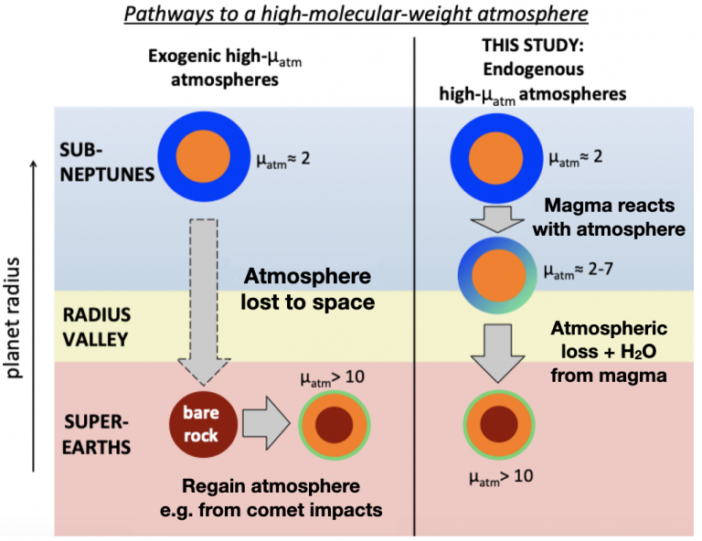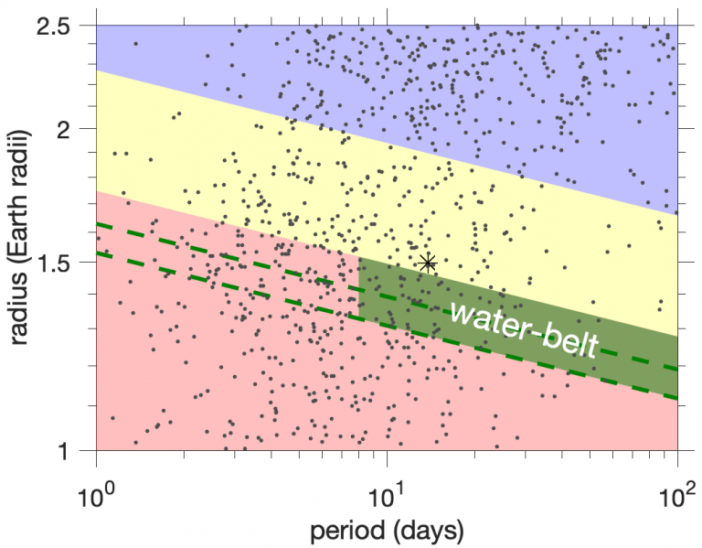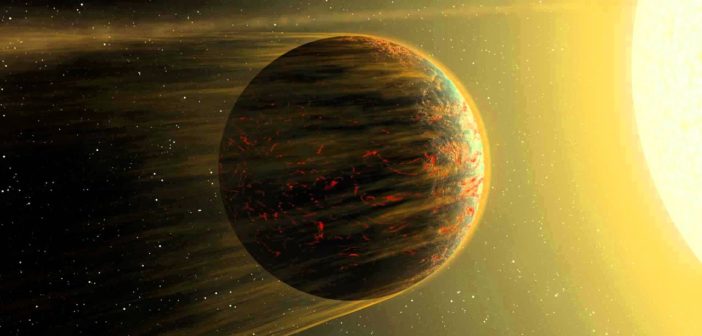Editor’s note: Astrobites is a graduate-student-run organization that digests astrophysical literature for undergraduate students. As part of the partnership between the AAS and astrobites, we occasionally repost astrobites content here at AAS Nova. We hope you enjoy this post from astrobites; the original can be viewed at astrobites.org.
Title: Water On Hot Rocky Exoplanets
Authors: Edwin S. Kite, Laura Schaefer
First Author’s Institution: University of Chicago
Status: Published in ApJL
Most Sun-like stars are thought to be home to a hot rocky exoplanet — which could mean that there are more than 300 million potentially habitable planets in our galaxy! However, whether any of these planets have atmospheres remains unknown. Unlike the Blue Marble we call home, the way that many of these planets form leaves them as dead rocks.
Most terrestrial planets larger than Earth (known as super-Earths) are thought to form as sub-Neptunes, consisting of a silicate magma ball surrounded by a thick atmosphere accreted from the planetary disc during formation. Because this atmosphere is dominated by light hydrogen molecules, it has a low mean molecular weight (µ, the average weight of each molecule in the atmosphere) and is later lost to space via atmospheric escape, leaving behind the bare super-Earth. While it’s possible for planets to later regain an atmosphere via volcanic activity or impacts from comets, what if there were a way for super-Earths to develop atmospheres while they evolve from sub-Neptunes?
Today’s paper explores a potential pathway that can not only generate super-Earth atmospheres, but could also allow them to be retained for billions of years.
When Magma Meets Air
The authors consider what happens to the products that form when a sub-Neptune’s magma reacts with its atmosphere. Iron oxides in the magma react with the atmospheric hydrogen, producing water, and iron, which sinks to the planet’s core. While some of this steam escapes into the atmosphere and mixes with the hydrogen, most of it dissolves and remains trapped in the magma, creating a planet made up of a slightly watery magma ball surrounded by a slightly higher-mean-molecular-weight atmosphere. But as the atmosphere begins to escape, what happens to the water?

Figure 1: A graphical representation of the potential pathways a sub-Neptune can take to become a super-Earth with a high-mean-molecular-weight (µatm) atmosphere. Blue atmospheres are hydrogen dominated, while green atmospheres are water dominated. The left-hand side shows a sub-Neptune losing its atmosphere to space, becoming a bare rock, and later regaining a high-µatm atmosphere. The right-hand side shows the pathway outlined in today’s paper, with a sub-Neptune evolving to a super-Earth with a water-dominated atmosphere via atmosphere–magma interactions. In each pathway, the sub-Neptune moves across the radius valley, decreasing in radius as it goes. [Adapted from Kite & Schaefer 2021]
Water, Water, Everywhere?
The length of time for which a planet has a water-dominated atmosphere depends on how aggressive the atmospheric loss is. While smaller planets very close to their stars are at higher risk for atmospheric loss, planets at greater distances from their stars are safer and may never endure the process. Planets in between these extremes are able to keep hold of their newly acquired water-dominated atmospheres for varying lengths of time, but could potentially retain them for billions of years. So which planets can we expect to have watery envelopes?
When plotted on a graph of planetary radius vs. orbital period, the larger-radius sub-Neptunes and smaller-radius super-Earths are separated by a lack of planets often known as the radius valley. As a sub-Neptune loses its atmosphere its radius decreases, moving it down through the radius valley. The authors predict that, provided the planet has a long enough period and the interactions between magma and atmospheres are sufficiently efficient, the evolving planets that are able to retain water-dominated atmospheres should be found lining the radius valley in a “water belt”, as seen in Figure 2.

Figure 2: The “water belt” of super-Earths, shown in period–radius space for planets orbiting stars less than 3 Gyr old. The blue region shows the area occupied by sub-Neptunes, while the red region shows the area occupied by super-Earths. The yellow region in between is known as the radius valley. The water belt, where super-Earths with water dominated atmospheres may exist, is shown in green. The upper and lower dashed lines give the water-belt predictions for magmas with lower and higher amounts of iron oxides present. [Kite & Schaefer 2021]
Original astrobite edited by Huei Sears.
About the author, Lili Alderson:
Lili Alderson is a first year PhD student at the University of Bristol studying exoplanet atmospheres with space-based telescopes. She spent her undergrad at the University of Southampton with a year in research at the Center for Astrophysics | Harvard-Smithsonian. When not thinking about exoplanets, Lili enjoys ballet, film and baking.

